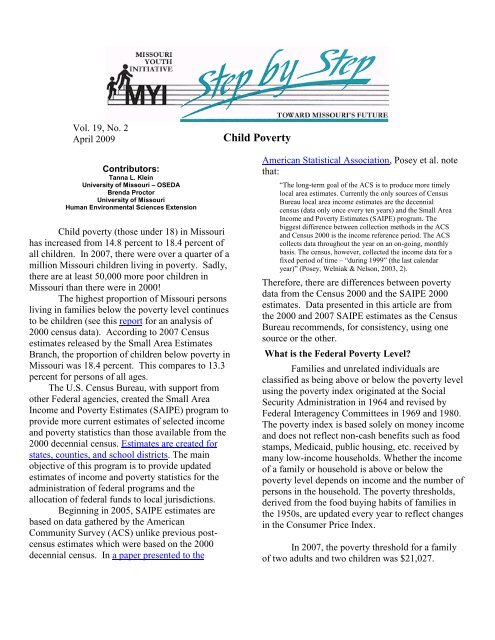View this issue in Adobe Acrobat Format - OSEDA - University of ...
View this issue in Adobe Acrobat Format - OSEDA - University of ...
View this issue in Adobe Acrobat Format - OSEDA - University of ...
Create successful ePaper yourself
Turn your PDF publications into a flip-book with our unique Google optimized e-Paper software.
Vol. 19, No. 2<br />
April 2009<br />
Child Poverty<br />
Contributors:<br />
Tanna L. Kle<strong>in</strong><br />
<strong>University</strong> <strong>of</strong> Missouri – <strong>OSEDA</strong><br />
Brenda Proctor<br />
<strong>University</strong> <strong>of</strong> Missouri<br />
Human Environmental Sciences Extension<br />
Child poverty (those under 18) <strong>in</strong> Missouri<br />
has <strong>in</strong>creased from 14.8 percent to 18.4 percent <strong>of</strong><br />
all children. In 2007, there were over a quarter <strong>of</strong> a<br />
million Missouri children liv<strong>in</strong>g <strong>in</strong> poverty. Sadly,<br />
there are at least 50,000 more poor children <strong>in</strong><br />
Missouri than there were <strong>in</strong> 2000!<br />
The highest proportion <strong>of</strong> Missouri persons<br />
liv<strong>in</strong>g <strong>in</strong> families below the poverty level cont<strong>in</strong>ues<br />
to be children (see <strong>this</strong> report for an analysis <strong>of</strong><br />
2000 census data). Accord<strong>in</strong>g to 2007 Census<br />
estimates released by the Small Area Estimates<br />
Branch, the proportion <strong>of</strong> children below poverty <strong>in</strong><br />
Missouri was 18.4 percent. This compares to 13.3<br />
percent for persons <strong>of</strong> all ages.<br />
The U.S. Census Bureau, with support from<br />
other Federal agencies, created the Small Area<br />
Income and Poverty Estimates (SAIPE) program to<br />
provide more current estimates <strong>of</strong> selected <strong>in</strong>come<br />
and poverty statistics than those available from the<br />
2000 decennial census. Estimates are created for<br />
states, counties, and school districts. The ma<strong>in</strong><br />
objective <strong>of</strong> <strong>this</strong> program is to provide updated<br />
estimates <strong>of</strong> <strong>in</strong>come and poverty statistics for the<br />
adm<strong>in</strong>istration <strong>of</strong> federal programs and the<br />
allocation <strong>of</strong> federal funds to local jurisdictions.<br />
Beg<strong>in</strong>n<strong>in</strong>g <strong>in</strong> 2005, SAIPE estimates are<br />
based on data gathered by the American<br />
Community Survey (ACS) unlike previous postcensus<br />
estimates which were based on the 2000<br />
decennial census. In a paper presented to the<br />
American Statistical Association, Posey et al. note<br />
that:<br />
“The long-term goal <strong>of</strong> the ACS is to produce more timely<br />
local area estimates. Currently the only sources <strong>of</strong> Census<br />
Bureau local area <strong>in</strong>come estimates are the decennial<br />
census (data only once every ten years) and the Small Area<br />
Income and Poverty Estimates (SAIPE) program. The<br />
biggest difference between collection methods <strong>in</strong> the ACS<br />
and Census 2000 is the <strong>in</strong>come reference period. The ACS<br />
collects data throughout the year on an on-go<strong>in</strong>g, monthly<br />
basis. The census, however, collected the <strong>in</strong>come data for a<br />
fixed period <strong>of</strong> time – “dur<strong>in</strong>g 1999” (the last calendar<br />
year)” (Posey, Welniak & Nelson, 2003, 2).<br />
Therefore, there are differences between poverty<br />
data from the Census 2000 and the SAIPE 2000<br />
estimates. Data presented <strong>in</strong> <strong>this</strong> article are from<br />
the 2000 and 2007 SAIPE estimates as the Census<br />
Bureau recommends, for consistency, us<strong>in</strong>g one<br />
source or the other.<br />
What is the Federal Poverty Level<br />
Families and unrelated <strong>in</strong>dividuals are<br />
classified as be<strong>in</strong>g above or below the poverty level<br />
us<strong>in</strong>g the poverty <strong>in</strong>dex orig<strong>in</strong>ated at the Social<br />
Security Adm<strong>in</strong>istration <strong>in</strong> 1964 and revised by<br />
Federal Interagency Committees <strong>in</strong> 1969 and 1980.<br />
The poverty <strong>in</strong>dex is based solely on money <strong>in</strong>come<br />
and does not reflect non-cash benefits such as food<br />
stamps, Medicaid, public hous<strong>in</strong>g, etc. received by<br />
many low-<strong>in</strong>come households. Whether the <strong>in</strong>come<br />
<strong>of</strong> a family or household is above or below the<br />
poverty level depends on <strong>in</strong>come and the number <strong>of</strong><br />
persons <strong>in</strong> the household. The poverty thresholds,<br />
derived from the food buy<strong>in</strong>g habits <strong>of</strong> families <strong>in</strong><br />
the 1950s, are updated every year to reflect changes<br />
<strong>in</strong> the Consumer Price Index.<br />
In 2007, the poverty threshold for a family<br />
<strong>of</strong> two adults and two children was $21,027.
Variations <strong>in</strong> Child Poverty Rates<br />
While 18.4 percent <strong>of</strong> children were considered below poverty <strong>in</strong> 2007, <strong>this</strong> cont<strong>in</strong>ues to vary widely across<br />
counties <strong>in</strong> the state. Rates ranged from a low <strong>of</strong> 5.7 percent <strong>in</strong> St. Charles County to a high <strong>of</strong> 46 percent <strong>in</strong><br />
Pemiscot County (see Table 1). As the map below illustrates, the Southeast, South Central and Bootheel regions<br />
cont<strong>in</strong>ue to have the highest child poverty rates.
Reference<br />
Posey, K. G., Welniak, E. & Nelson, C. (2003). Income <strong>in</strong> the American Community Survey: Comparisons to<br />
Census 2000. Retrieved March 26, 2009 from http://www.census.gov/acs/www/Downloads/ACS/ASA_nelson.pdf.<br />
Resources<br />
National Center for Children <strong>in</strong> Poverty, Missouri State Pr<strong>of</strong>iles<br />
http://www.nccp.org/pr<strong>of</strong>iles/state_pr<strong>of</strong>ile.phpstate=MO&id=6<br />
http://www.nccp.org/pr<strong>of</strong>iles/state_pr<strong>of</strong>ile.phpstate=MO&id=7<br />
Child Trends Brief: Children <strong>in</strong> Poverty: Trends, Consequences, and Policy Options<br />
http://www.childtrends.org/Files//Child_Trends-2009_04_07_RB_Children<strong>in</strong>Poverty.pdf


